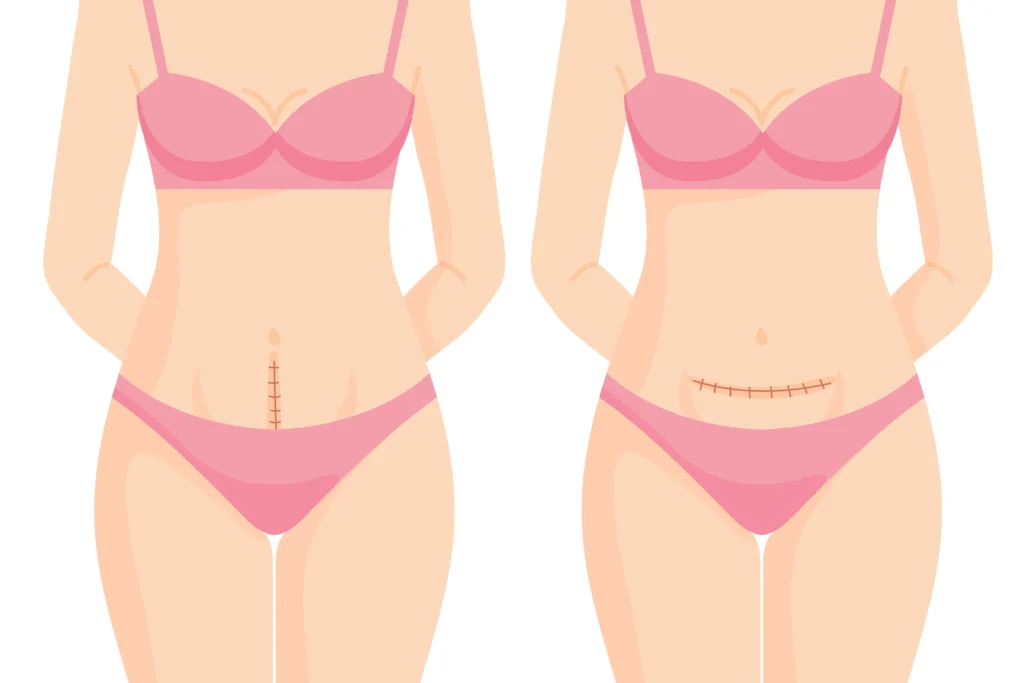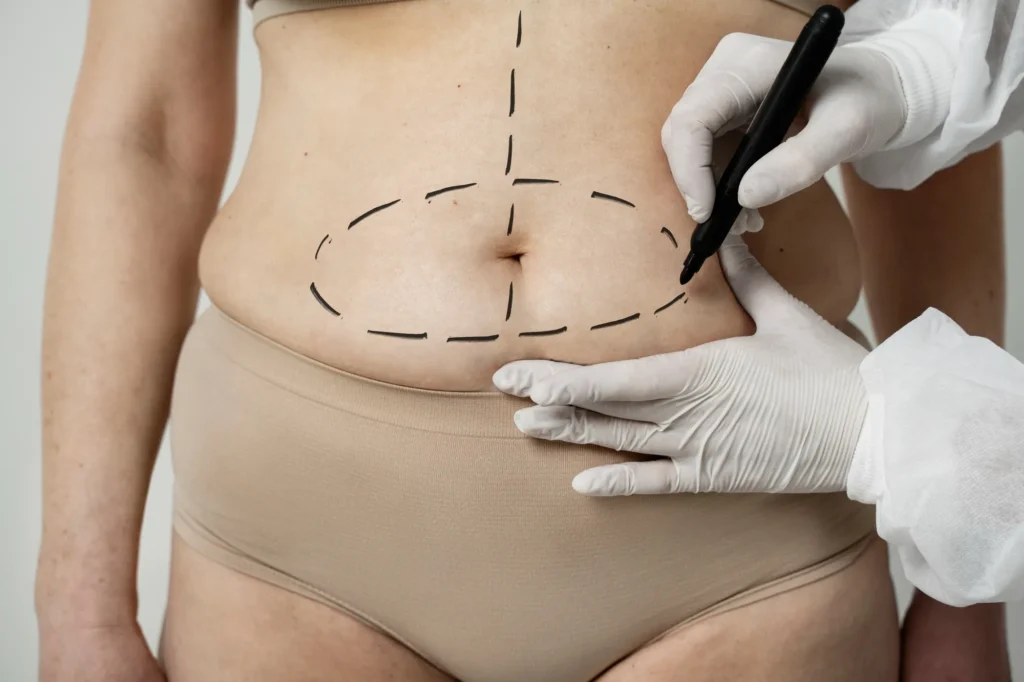Dr. Shazma Yousaf
Plot no : 40 Jhelum Rd, G 8/4 G-8, Islamabad, Pakistan
Tummy Tuck (also known as abdominoplasty) surgery can flatten your abdomen by removing loose, excess fat and skin that does not shrink with diet and exercise. It can also remove some of the stretch marks on your lower abdomen. This surgery usually results in a flat tummy and instantly improves self-confidence and body image.
A tummy tuck in Islamabad is also recommended for reducing lax, saggy skin caused by ageing, previous surgery, or spinal deformities with or without abdominal muscle weakness. However, you must know that this procedure does not reduce weight by removing large quantities of fat but is performed only to offer aesthetic contouring to the abdominal region.
Surgery time: | 3 to 3.5 hours |
Recovery Time: | 2 to 3 week for full recovery |
Anesthesia | General anaesthesia |
Type | The patient goes home 1 day after surgery |
Post-operative Care | Bed rest for 24-48 hours, limited mobility for 10 days. compression garment for 6 weeks (lipo-abdominoplasty) prescription medication for 7 days, no strenuous activities including exercise for 6 weeks (excluding walking). |
A Tummy Tuck is a popular cosmetic procedure usually opted after pregnancy, significant weight loss, or whenever a flabby abdomen with weak muscles affects your upper body contours.
There are a number of factors to consider before the tummy tuck procedure. So if you wish to get this surgery, here are some essential factors you need to know:
During the consultation, Dr Shazma Yousaf will take a detailed medical history and examine you to check if a tummy tuck would be appropriate for you. This process will also include choosing the right treatment options, such as a mini or full tummy tuck procedure with or without liposuction.
Dr Shazma Yousaf will discuss the detailed treatment plan, placement of scars, potential risks, post-operative recovery, expectations and alternative treatments. This procedure is usually performed under general anaesthesia. All other aspects of this procedure are also discussed during the initial consultation. Please feel free to ask Dr Shazma yousaf any questions that you have.
Any surgery necessitates planning, which begins with a consultation with your plastic surgeon for a thorough examination. Dr Shazma needs to be aware of any health issues, medications you regularly take, allergies, and any other concerns you may have.
It’s critical to communicate the outcomes you’re looking for. You can use some before and after examples to show what you want to accomplish. Because each case is unique and the outcome is dependent on the initial body problems and genetic characteristics, it is critical that you have realistic expectations. Dr Shazma will tell you if you’re a good candidate for an abdominoplasty and what to expect from the procedure.

Unlike most cosmetic surgeries, a tummy tuck isn’t performed as an outpatient procedure in most cases, meaning you may have to stay at the hospital for at most a day after the surgery.
It is a complex procedure that requires extensive pre-planning to treatment setups to achieve the desired results. Dr Shazma, who frequently performs tummy tuck surgery in Islamabad, typically conducts it in the following steps.
General anaesthesia is used to keep you asleep throughout the surgery.
A long horizontal incision is made between your pubic hairline and belly button across the frontal hip. This incision can vary in length for individual patients depending on the extent of skin to be removed.
The abdominal skin is gently lifted, and the underlying abdominal muscles and stretched and tightened. A liposuction device may also be used to remove small pockets of fat if required.
The lifted skin is adequately stretched to match the new abdominal wall shape, and the excess skin ends are trimmed.
The new skin edges are sutured at the incisions, and a new belly button hole may also be created.
Finally, the belly button is reattached, and the entire region is covered with surgical dressings.
A mini-abdominoplasty is recommended when there is moderate skin looseness but no abdominal diastasis. Mini abdominoplasty is a procedure that removes excess skin and fat from the lower abdomen (below the belly button) without affecting the abdominal wall muscles. It is not necessary to remove skin above the navel or treat the navel itself in these cases.
Abdominoplasty in Islamabad is recommended for patients with more noticeable skin looseness, excess fat, and a prominent abdomen due to diastasis; it involves removing excess fat and skin and repositioning the muscles and belly button.
An extended tummy tuck is recommended when the patient also needs to improve the appearance of love handles on either side of the hips, in addition to the upper and lower abdominal skin. It involves a longer incision and more extensive surgical work for creating a lean and attractive figure.
Abdominoplasty and liposuction are frequently combined. Abdominoplasty and liposuction are both surgical procedures that aim to improve the abdomen’s appearance, but they differ significantly.
While liposuction is recommended for patients who have localized fat and good skin elasticity, abdominoplasty is recommended for patients who have excess fat, saggy skin, or abdominal bulging (due to muscle stretching).
If an abdominoplasty candidate only has liposuction, the result will be an abdomen with less fat but more pronounced sagging. Abdominoplasty and liposuction, on the other hand, complement each other. Because most people who want an abdominoplasty also have fat in their abdomen and other parts of their bodies, most abdominoplasty surgeries are combined with abdominal liposuction.
Many abdominoplasty patients, particularly women who have given birth or lost a significant amount of weight, also experience changes in their breasts. As a result, an abdominoplasty is frequently combined with a breast lift or reduction. In the case of men, removing excess fat or breast tissue is a common treatment for gynecomastia, often combined with a tummy tuck.
These are common procedures, particularly in obese patients with saggy skin in the abdomen and other body areas. Here, the surgeon performs liposuction around the thighs, buttocks, and/or underarms to reshape their contours to suit the new abdominoplasty results.

One of the most common concerns among abdominoplasty patients is the recovery time. Is it going to be painful? Is it okay if I drive afterwards? When will I be able to return to work or the gym? These are common concerns, and you should be aware of them so that you can prepare better. If you have abdominoplasty or a mini-abdominoplasty, here’s what you can expect during recovery.
Symptoms to expect following an abdominoplasty include pain in the treated and surrounding areas along with discomfort, swelling, and bruises which will subside in some time.
You will feel tired and exhausted when you wake up from surgery. The first three days are the most unpleasant, with swelling, bruising, and the sensation of “pull” d” abdomen. Patients who are unable to stand straight and have a curved posture are very common. At this point, take the prescribed medication to help relieve the common discomfort or pain.
Most post-operative symptoms will fade in 1 to 2 weeks, but swelling and discomfort are expected. After ten days, most patients can drive, socialise, and perform light activities. After about two weeks, you should be able to return to work.
The true results are visible about a month after surgery when most of the swelling and bruising has subsided. After that, you can resume physical activity, but it is best to start slow as you have been inactive for some time. You can also stop wearing the compression garment at this point.
The swelling may ‘hide’ the true results early on. However, once you can fully stand up straight after 1 to 2 weeks, you will notice that your abdomen is flatter, firmer, and more proportional to the rest of your body.
As the recovery progresses, the results will become more apparent. After 3 to 6 months, the final result is expected.
Keep your follow-up appointments and let your plastic surgeon know if you have any concerns.
To reduce the risk of complications, follow all medical guidelines advised by the surgeon diligently. During your medical appointment, every risk and complication will be thoroughly explained.
If you suffer from post-surgical complications such as bleeding, infections, numbness, etc., reach out to Dr Shazma yousafright away.
Plot no : 40 Jhelum Rd, G 8/4 G-8, Islamabad, Pakistan
© Dr Shazma Yousuf . All Rights Reserved.
Terms & Conditions Privacy Policy